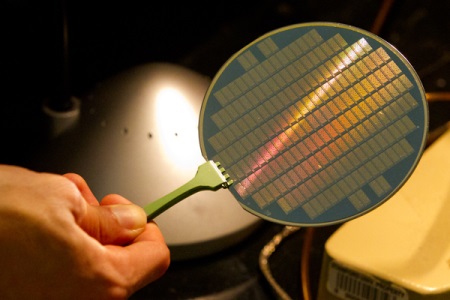Researchers at Stanford built a basic computer using carbon nanotubes, a semiconductor material that has the potential to launch a new generation of electronic devices that run faster, while using less energy, than those made from silicon chips. This unprecedented feat culminates years of efforts by scientists around the world to harness this promising but quirky material. The research, led by Stanford professors Subhasish Mitra and H.-S. Philip Wong, could galvanize efforts to find successors to silicon chips.
CNTs are long chains of carbon atoms that are extremely efficient at conducting and controlling electricity. It takes very little energy to switch them off, according to Wong, a co-author of the paper.
In theory, this combination of efficient conductivity and low-power switching make carbon nanotubes excellent candidates to serve as electronic transistors.

This wafer contains tiny computers using carbon nanotubes, a material that could lead to smaller, more energy-efficient processors. (Courtesy of Norbert von der Groeben Stanford University)
Stanford researchers think CNTs could take technology at least an order of magnitude faster than silicon. But inherent imperfections have stood in the way of putting this promising material to practical use.
First, CNTs do not necessarily grow in neat parallel lines, as chipmakers would like. Over time, researchers have devised tricks to grow 99.5% of CNTs in straight lines. But with billions of nanotubes on a chip, even a tiny degree of misaligned tubes could cause errors, so that problem remained.
A second type of imperfection has also stymied CNT technology. Depending on how the CNTs grow, a fraction of these carbon nanotubes can end up behaving like metallic wires that always conduct electricity, instead of acting like semiconductors that can be switched off. Since mass production is the eventual goal, researchers had to find ways to deal with misaligned and/or metallic CNTs without having to hunt for them like needles in a haystack.
To eliminate the wire-like or metallic nanotubes, the Stanford team switched off all the good CNTs. Then they pumped the semiconductor circuit full of electricity. All of that electricity concentrated in the metallic nanotubes, which grew so hot that they burned up and literally vaporized into tiny puffs of carbon dioxide. This sophisticated technique eliminated the metallic CNTs in the circuit.
The Stanford researchers created an algorithm that maps out a circuit layout that is guaranteed to work no matter whether or where CNTs might be askew. The team used this design to assemble a basic computer with 178 transistors, a limit imposed by the fact that they used the university's chip-making facilities rather than an industrial fabrication process. Their CNT computer performed tasks such as counting and number sorting. It runs a basic operating system that allows it to swap between these processes. In a demonstration of its potential, the researchers also showed that the CNT computer could run MIPS, a commercial instruction set developed in the early 1980s. Though it could take years to mature, the Stanford approach points toward the possibility of industrial-scale production of carbon nanotube semiconductors.
For more information http://news.stanford.edu/news/2013/september/carbon-nanotube-computer-092513.html
Advertisement





